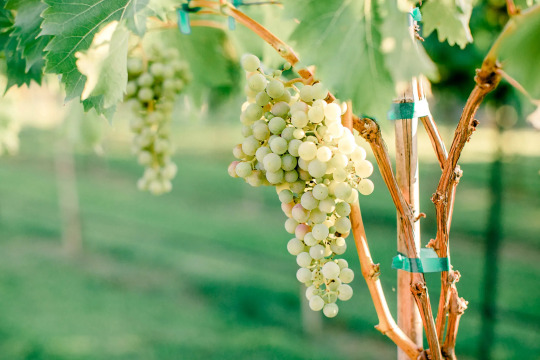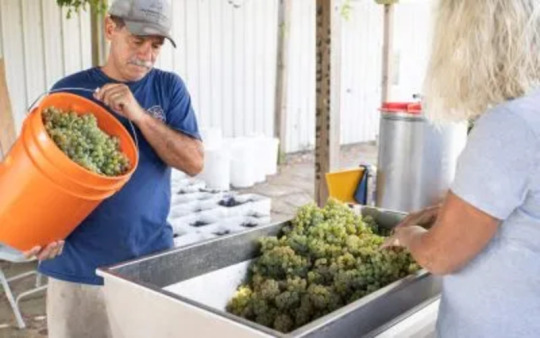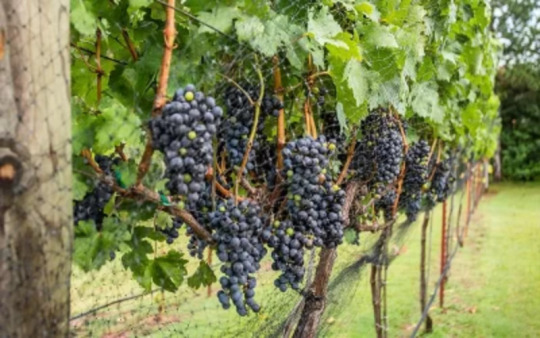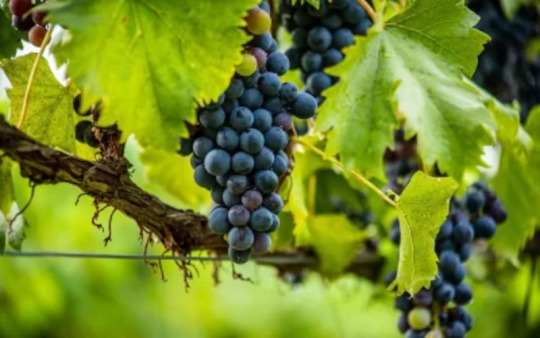#OklahomawinerynearI40
Text
WHAT IS AN ESTATE OKLAHOMA WINERY?

While exploring a discover Oklahoma winery, you may notice “estate winery” in the title or “estate bottled” or “estate grown” on the wine labels. The meanings of these terms vary throughout the world. Some countries use the term “estate” in the same way the United States uses the term “estate-bottled” when discussing wine.
Although these words are often used interchangeably, each has a different meaning in American winemaking, providing some insight into how your local wine was produced.
What Is An Estate Winery?
If an Oklahoma winery uses the term “estate winery,” the winery controls the winemaking process. The winery has complete control, from growing the grapes to bottling the wine.
Many wineries use the terms “estate” or “estate-grown” on their labels freely because it is not a legally-bound term in the federal government. These terms, while indicating how the wine may have been produced, are a broad definition.
Estate or estate-grown wines are typically grown on the same property and region. Still, the vineyards themselves may be on different plots of land. An Oklahoma winery near I-40 manages or controls the production of the wine, but they may own all, some, or none of the land in which the grapes are grown. In sum, as long as the same entity farms the wine, wineries can use the terms “estate” or “estate-grown.”
What Are Estate-Bottled Wines?
Using the term “estate-bottled” grows more complicated. Wines labeled as “estate-bottled” are backed by specific legal requirements determined by the federal government. For a winery to use this term, 100% of the wine must be owned and farmed by the same entity. An Oklahoma winery must own all the land, vineyards, and grapes and produce the wine within the same American Viticultural Area. From wine to bottle, an estate-bottled wine never leaves the winery’s premises, giving them complete control of the entire process.
The American Viticultural Area, or AVA, must be classified on an estate-bottled wine label. The AVA is the specific type of appellation of origin indicating that growing grapes used in the wine distinctly differ from growing grapes in other geographic regions. Contact an Oklahoma winery near I-40 to discover your wine’s AVA.
What About Single-Vineyard Wines?
Single-vineyard wines are when the grapes are grown in one vineyard. Because of some overlapping characteristics, estate or estate-bottled wines can also be considered single-vineyard wines.
It is commonly assumed that estate, estate-bottled, and single-vineyard wines are of the highest quality. However, this is not necessarily true. Several factors, such as climate, grape varietal, fermentation process, individual preferences, and more, play a role in determining the quality of the wine.
Ready to Discover Oklahoma Wineries?
Whether you are looking for single-vineyard or estate-bottled wines, you are sure to find some new favorites in Oklahoma. At the Oklahoma Grape Industry Council, we have over 60 members that are ready to help you cultivate a love for Oklahoma wine. Contact us today for more information, or visit our website to find a discover Oklahoma winery near you.
#Oklahomawinery#OklahomawinerynearI40#discoverOklahomawinery#madeinoklahomawine#buylocalwines#oklahomawineryneari35#oklahomawinetours#winetastingokc#growinggrapesinoklahoma#oklahomavineyard
0 notes
Text
WHAT IS A CRUSH PAD FOR AN OKLAHOMA WINERY NEAR I-40?

If you tour an Oklahoma winery near I-40, you may see some of the equipment used to produce delicious wines, such as tanks, pumps, and barrels. One area that has a vital role in winemaking is a “crush pad,” as it is where the process of transforming grapes into wine begins.
There are five primary stages of winemaking: (1) harvesting, (2) crushing and pressing, (3) fermentation, (4) clarification, and (5) aging and bottling. As referenced in its name, crush pads are used during the second step of the process.
The History of Crush Pads
For thousands of years, winemakers would manually crush grapes to prepare the juice for fermentation. When considering this process, the first image to come to mind is likely that of people stomping on grapes in barrels or large vats. The area or platform where this took place became known as a “crush pad.”
Modern Crush Pads at an Oklahoma Winery Near I-35
Due to many advancements in winemaking technology, crushing grapes into pulp and juice is no longer an entirely manual process. Current crush pads can be understood as the part of an Oklahoma winery near I-35 designated for the equipment used to process harvested grapes into wine.
How Are the Grapes Crushed?
After the grapes are harvested, everything is brought to the crush pad. After unwanted materials (like leaves) are removed and the best grape clusters are selected, winemakers move the clusters into a machine to be crushed. There are various types of machinery used for this process; for example, a winery may have a:
Crusher-destemmer: the equipment crushes the grapes before removing them from the stem.
Destemmer-crusher: the machine removes the stems from the grapes before crushing them.
Destemmer-only: the equipment only removes stems, with a different method used for crushing.
These machines vary in size and price. They may also be manually operated or fully motorized. This allows each Oklahoma winery to select the ideal equipment for its needs.
What Happens After the Grapes are Crushed?
Once the grapes are crushed, the resulting mix of juice, skins, and seeds is referred to as a “must.” From this point, the winemaking process slightly diverges based on the type of wine that the Oklahoma winery is making:
White wine: the must is pressed before fermentation, often shortly after it is crushed. This process separates the juice from all solids, meaning that the wine’s flavor and color are unaffected by the skins and seeds.
Red wine: the must is fermented as-is, allowing the wine to gain its strong color, flavor, and tannins from the seeds and skins. The must is pressed after fermentation, removing all solids to leave a smooth red wine.
After fermentation and pressing (in either order), the next step is clarification. At this time, leftover pulp, stems, and skins become suspended in the wine, along with any unwanted proteins, tannins, and other phenolic compounds. Once these unwanted materials are filtered out, the red or white wine is bottled and aged until it is ready to be enjoyed.
Interested in Visiting an Oklahoma Winery Near I-40?
While the crush pad is an important part of any winery that produces wine, it is only one of the many key parts of the business. To build a true appreciation of the hard work that goes into creating delicious, high-quality wines, consider scheduling a winery tour that brings you through the entire winemaking process.
#OklahomawinerynearI40#OklahomawinerynearI35#Oklahomawinery#growinggrapesinoklahoma#madeinoklahomawine#winetastingokc#buylocalwines#oklahomawinetours#traveloklahomawinery#oklahomavineyard
0 notes
Text
QUESTIONS TO ASK WHEN LOOKING AT AN OKLAHOMA WINERY MAP*=

If you want to sample wines that are only created in our state, an Oklahoma winery map can help you find the perfect destination. The wineries and vineyards featured there will each provide a unique experience to its visitors. To plan your perfect wine tasting trip, there are a few questions you should ask yourself when looking at the map.
4 Things to Ask When Looking at an Oklahoma Winery Map
1. How Many Wineries and Vineyards Should I Visit?
Our state has many wineries and vineyards; in fact, over 30 members of the Oklahoma Grape Industry Council are wineries! There are many possible destinations, so try to limit yourself to a select few. When you give yourself the time to enjoy each location, you can gain a true appreciation for the space and its unique wines.
It is easier to determine the ideal number of locations to visit when you consider the length of your trip. If you are planning a day-long tasting experience, limiting yourself to 1-3 wineries and vineyards that are near one another could be best. If your trip will be over multiple days, you can visit several more destinations without feeling rushed.
2. What Time of Year Should I Go?
While you can (usually) visit a winery or vineyard at any time of the year, the season can determine the experience you have there. For example, if you discover Oklahoma vineyards between the late spring and early fall, you may be able to observe parts of the grape growing and harvesting process. If you visit a winery in the fall or winter, you can still have a wonderful tasting experience, and it may feel more personal as there could be fewer visitors.
3. Should I Make Reservations for the Visits?
Many spaces will gladly allow walk-in visitors; however, that is not always the case. To ensure you can visit each of your preferred destinations, call ahead. In addition to reserving a spot in a vineyard tour or wine tasting, you could become one of the first to learn about special events and offerings. Also, some locations are closed for part of the year or may have limited hours due to events, so calling ahead can help you become aware of unexpected changes.
4. Do I Know the Best Way to Discover Oklahoma Wines?
When visiting the wineries or vineyards featured on the map, you can discover Oklahoma wines made on the premises. You should know the types of wine you want to try before visiting the destinations; this can ensure that there is something in each space that appeals to your palate. Remember to also keep an open mind, as trying new wines can help you find new favorites.
To truly appreciate the wines you sample at the wineries or vineyards, try to follow the 4 S’s of wine tasting. When you know how to properly See, Swirl, Sniff, and Spit the wines, you can perfect your palate and notice the intricate flavors of each red, white, or rosé wine. Of course, you should also remember the fifth S: Savoring each wine!
Discover Oklahoma Vineyards and Wineries
If you are planning a wine tasting trip through our state, make sure to visit members of the Oklahoma Grape Industry Council! These wineries and vineyards each produce delicious wines and provide unique experiences. To learn more about our members, please contact us.
#OklahomaWineryMap#discoverOklahomavineyards#discoverOklahomawines#madeinoklahomawine#winetastingokc#buylocalwines#oklahomawineryneari40#oklahomawineryneari35#oklahomawinetours#growinggrapesinoklahoma
0 notes
Text
WINE TASTING OKC BASICS: THE DIFFERENCE BETWEEN SWEET AND DRY WINES

Choosing a wine to try can seem difficult, especially if you are new to the world of wine. The choices are endless, from reds and whites to still and sparkling wines. Attending a wine tasting OKC is an excellent way to introduce yourself to various wines to help find your favorites. You will also learn how to appreciate the qualities of different wines, such as their dryness or sweetness.
Sweet vs. Dry Wines: What’s the Difference?
Wines are considered dry when they have less than 1 percent residual sugar. Oklahoma wines with less than 0.5 percent residual sugar are considered “bone dry,” having been completely stripped of their residual sugar. The taste buds hardly detect the minimal amount of sugar in bone-dry wines. On the contrary, sweet wines have residual sugar amounts above 20 percent. Off-dry wines are considered somewhere in between.
How Does Fermentation Affect a Wine’s Sweetness?
The primary factor determining whether made in Oklahoma wine is sweet or dry is the amount of residual sugar left behind during fermentation. The sugars begin to accumulate in the grape while it is still on the vine, especially in warmer climates. The riper the grape, the more sugar that it accumulates.
Once the grapes are harvested and crushed into juice, active yeast is added to begin fermentation. During this process, the yeast eats the natural sugars to produce alcohol. If the wine does not ferment for very long, the yeast cannot consume and convert the sugars into alcohol, resulting in a sweet wine. The longer the wine ferments, the more sugar the yeast consumes, resulting in a drier wine with higher alcohol content.
Other Factors That Impact the Sweetness of Made in Oklahoma Wine
Although fermentation is the main factor that impacts the sweetness of the wine, the wine’s acidity, tannin, and alcohol levels also play a significant role.
Acidity
Acidity refers to the crisp, tart citrus flavors that you taste in the wine. High acidity can make a wine drier. Immature grapes and those grown in cooler climates tend to produce more acidic wines.
Tannins
People often get tannins confused with acidity. Instead of a specific flavor, tannins impact the texture of Oklahoma wines. Tannins come from grape seeds and skins. As a group of phenolic compounds, tannins bind to the proteins in saliva, resulting in a dry feeling in your mouth. The more tannins, the drier the wine will be.
Alcohol
Going back to the fermentation process, winemakers use active yeast to convert sugars into alcohol. If a wine has a higher alcohol content, fewer sugars are present, making the wine drier.
Try Sweet and Dry Wines at a Local Winery Near You
Discovering the perfect wine requires some exploration to determine what you like. At the Oklahoma Grape Industry Council, we have over 60 members statewide ready to serve you delicious local wines and provide exceptional experiences. For more information about our organization or to find a wine tasting OKC near you, please reach out to us.
#winetastingOKC#madeinoklahomawine#Oklahomawines#buylocalwines#oklahomawineryneari40#oklahomawineryneari35#winetastingokc#growinggrapesinoklahoma#oklahomavineyardsnearme#oklahomawinerynearme
0 notes
Text
Our Members | Oklahoma Grape Industry Council
From vineyard and wineries owners to hobbyists, our members stay connected and informed about legislation, education, and available resources. Learn more!

#buylocalwines#discoverOklahomawines#oklahomawineryneari40#winetastingokc#growinggrapesinoklahoma#madeinoklahomawine#oklahomawinetours#oklahomavineyard#oklahomawinery#oklahomawines
0 notes